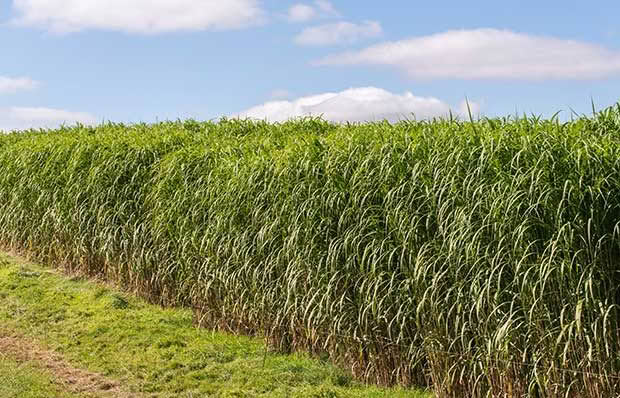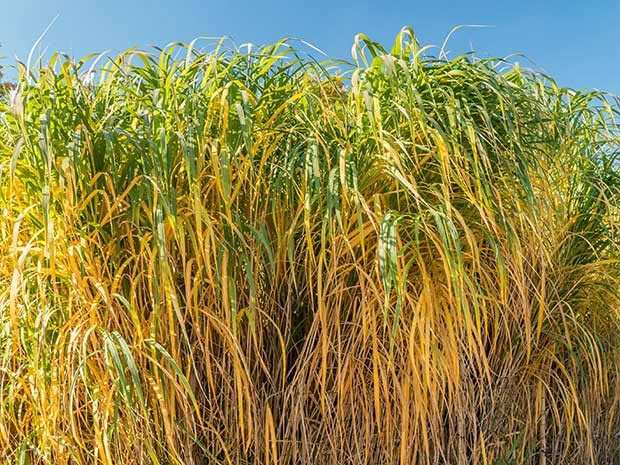6 reasons why you need to grow miscanthus grass

Lincoln University Professor Steve Wratten and PhD student Chris Littlejohn with the trial of perennial grass Miscanthus x giganteus.
When we think of grass, it’s usually the soft, knee-height-at-most pasture plant. But a giant sterile hybrid grass that grows to 4m and looks a bit like bamboo could be the answer to a lot of problems on farms, especially in Canterbury where many have lost shelterbelts in big storms in recent years.
Words: Nadene Hall
A trial of perennial grass Miscanthus x giganteus at the Kirwee farm of Mark Williams by Lincoln University PhD student Chris Littlejohn, has shown this giant grass has a lot of benefits to offer.
1. IT’S GREAT SHELTER
Littlejohn’s was the first known study looking at its value as a shelterbelt plant.
He says miscanthus can provide good shelter for dairy cows at its mature height of 4m, and reduced moisture loss in soils to produce an 8-10% increase in grass growth.
“The main function was to replace the shelterbelts that dairy farmers cut down because when these enormous (irrigation) pivots go in a circle they can’t push through the trees and shrubs. This [plant] provides excellent shelter for animals, pasture growth downwind, and when the irrigation comes along it passes through the growth and it flicks up again.”
Miscanthus reaches its maximum height in late spring and early summer when shelter from sun and wind is needed most.
The bonus is that pasture plants on the sheltered side also benefit: Lincoln research has shown clover plants keep their stomata open wider and longer when protected from Nor’westers than unprotected plants.
This results in an overall increase in pasture Dry Matter of 18% within 40m downwind, and a 20% reduction in evapotranspiration.

2. IT’S HIGHLY UNLIKELY TO BE A PEST PLANT
Miscanthus x giganteus is a sterile hybrid so it can’t reproduce itself by seed and spreads only slowly by creeping rhizomes (about 10cm a year). It’s easily controlled by grazing or spraying, and its roots don’t compete with the adjacent pasture, meaning grass can grow right up to it. Competition with crops is equally slight.
The Lincoln researchers have shown that it also provides habitat for bumble bees and native skinks. It doesn’t produce a thick base and encourage rodents like flax does either.
3. IT’S VERY EASY TO MAINTAIN
Establishment takes about the same amount of work as planting a shelterbelt using trees, but after the first full year, it is maintenance-free, requiring no thinning, trimming etc.

4. IT CAN BE TURNED INTO DIESEL
If irrigated, miscanthus can yield up to 30 tonnes of dry matter per hectare, which can be turned into about 9000 litres of renewable diesel per hectare at a cost of around $1.10 per litre.
At the most basic end of the scale, baled miscanthus straw can be used in boilers as a replacement for coal and as fuel pellets for domestic wood pellet fires.
However, it would take time for these markets to become established in New Zealand as it would require specialist equipment to produce it on a large scale.
5. IT CAN BE TURNED INTO BEDDING
Miscanthus makes good animal bedding as it is a lot tougher than cereal straw so it lasts longer, and it has other beneficial properties such as helping to reduce bad smells. Overseas, it is particularly popular as a bedding for horses due to its low dust content.
6. IT CAN BE TURNED INTO STOCK FEED
While the live plant is palatable to stock – cows happily grazed the plants in field trials — it is a low-grade feed.
The feed quality falls even lower once plants are dried and harvested, but it can provide the roughage component of a winter feed in place of something like cereal straw.
Source: www.bhu.org.nz
Love this story? Subscribe now!
 This article first appeared in NZ Lifestyle Block Magazine.
This article first appeared in NZ Lifestyle Block Magazine.
